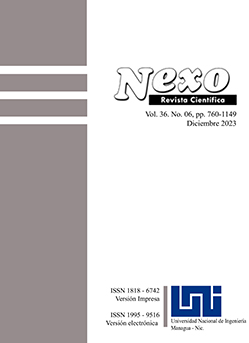Evaluation of the potential of mycorrhizal fungi and RHIZOBIUM bacteria in the phenological development and yield of the bean (PHASEOLUS VULGARIS) crop
DOI:
https://doi.org/10.5377/nexo.v36i06.17436Keywords:
Micorrizas, Yield, Rhizobium, Phenological developmentAbstract
The study was carried out at the National Center of Reference in Agroplaticultura (CNRA) of the UNAN-León Agricultural Campus. Beans (Phaseolus vulgaris) have historically been cultivated based on the basic diet of Nicaraguans. . The objective of this research was to evaluate the availability of nutrients in soils inoculated with Mycorrizas and Rhizobium, analyzing their effect on the vegetative development and yields of the bean (Phaseolus vulgaris) crop. The design used was a BCA in which three blocks were established, randomly distributed in the study area, this was divided into 4 treatments (T1: Mycorrizas, T2: Rhizobium, T3 Mycorrizas + Rhizobium and T4: Control) with 3 repetitions for a total of 12 experimental units, each experimental unit was 3m long by 3m wide with a separation between each subplot of 0.50cm. An Analysis of Variance (ANOVA) was performed using the statistical program SPSS with 95% confidence and making a comparison of means with Tukey. The results showed that there was a significant difference between the treatments, where T3 obtained the highest average height, diameter, number of leaves, number of pods, grains per plant, spore count and production with 1,798 Kg/Ha. It is concluded that the variables are influenced by the inoculum with Mycorrizas and Rhizobium, registering the highest averages and the highest yield in the treatment: Mycorrizas + Rhizobium.
Downloads
Downloads
Published
How to Cite
Issue
Section
License
Copyright (c) 2024 Array

This work is licensed under a Creative Commons Attribution 4.0 International License.
The authors who publish in Nexo Scientific Journal agree to the following terms:
- Authors retain the copyright and grant the journal the right of the first publication under the license Creative Commons Attribution License https://creativecommons.org/licenses/by/3.0/, which allows others to share the work with a recognition of the authorship of the work and the initial publication in Nexo Scientific Journal.
- Authors may separately establish additional agreements for the non-exclusive distribution of the version of the work published in the journal (for example, in an institutional repository or a book), with the recognition of the initial publication in Nexo Scientific Journal.
- Authors are allowed and encouraged to disseminate their works electronically (for example, in institutional repositories or in their own website) before and during the submission process, as it can lead to productive exchanges, as well as earlier and greater citation of published works.











